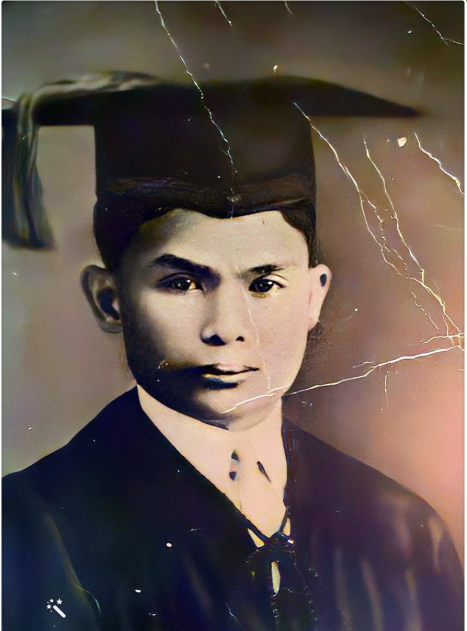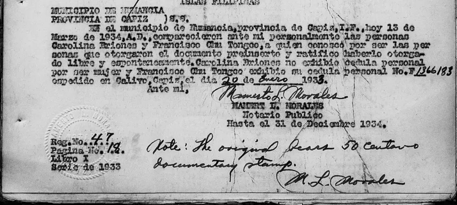The Story of Mamerto Morales and Agtawagon Hill
Mamerto Morales graduation photo, 1939 - captured at the height of his success as a professional and community leader
How one family's tragedy during World War II reveals the hidden connections between individual lives and the sweeping currents of Philippine history
Part of the Storyline Genealogy series: Uncovering the extraordinary stories hidden in ordinary family histories, one ancestor at a time.
Sometimes genealogy research leads you to places you never expected to go. What began as a routine investigation into a family death record has become a story that perfectly illustrates why Storyline Genealogy exists – because behind every name in a family tree lies a human story that deserves to be told.
A Graduation Photo and a Family Mystery
Picture a young man in 1939, standing proudly in graduation robes, his eyes bright with the promise of a future that would never come. This is Mamerto Morales, captured in what may be the last photograph ever taken of him.
Born around 1900 in Kalibo, Aklan, Mamerto grew up in a family that carried significant weight in their community. His father Juan Morales had deep roots in the region, and the family name was so respected that an entire barangay would eventually bear it. His half-brother Magin would become mayor of Altavas, while Mamerto himself worked hard to become a notary public during the 1930s.
The Professional Man, The Family Father
Mamerto as Notary Public
By 1936, Mamerto had built what seemed like a secure life. As a notary public, he spent his days helping neighbors with their most important transactions – selling family farms, mortgaging rice fields, transferring coconut plantations. People trusted him with their life's work because he understood both the law and their struggles.
He married Patrocinio Gonzales, and together they were raising their children in the town where his father was born. Their son Romulo would grow up to become a doctor. Young Miguel would graduate from law school and eventually sail to California. Virgilio, born in 1936, would one day settle in Michigan. These details matter because they show us a family with ambitions, with plans, with futures they were building together.
When the World Collapsed
That 1939 graduation photograph shows Mamerto at the height of his success – a professional man, a father, a pillar of his community. He had no way of knowing that just three years later, the world would collapse around him.
When the Japanese invaded in December 1941, everything changed. Educated men like Mamerto became targets. Notaries, lawyers, civic leaders – they were hunted down. The family that had lived openly and proudly suddenly had to hide, to run, to survive however they could.
The Final Journey
The steep, forested mountains of Balete where Mamerto made his final journey - terrain that rises at brutal 30-degree angles
In 1942 – just three years after that hopeful graduation photo – the danger finally found them.
Picture that terrifying day when the family had to flee their home. Mamerto, now around 42, gathered what he could carry – a heavy sack of rice, perhaps the difference between his family's survival and starvation. The escape route led uphill, into the steep mountains of Balete, toward Agtawagon Hill in the very barangay that bore his family's name.
Here's where this story becomes remarkable in its tragic irony: Mamerto was fleeing toward Barangay Morales – land that had been named in 1917 to honor Capitan Florentino Morales, likely one of his own relatives. The very hill that would claim his life was in territory where his family name was literally written on the map.
Imagine Mamerto climbing those brutal slopes – land that rises at 30-degree angles, rocky terrain that had been fortified since the Philippine Revolution. He was running for his life, carrying the weight of his family's future on his back, literally. His six-year-old son Virgilio and eleven-year-old Romulo watched as their father struggled up that hill with the rice sack, probably the last food they had.
Then it happened. Somewhere on those steep slopes of Agtawagon Hill, Mamerto's back gave out under the strain. Maybe it was the weight of the rice, maybe it was the desperate pace, maybe it was the terror of being hunted. But in that moment, carrying rice up a mountain to save his family, Mamerto Morales broke.
The family never saw him again.
Why This Story Matters
This is what makes genealogy research so much more than dates and documents. Both boys – six-year-old Virgilio and eleven-year-old Romulo – carried their father's story for over seventy years. Every detail preserved in the memory of two children who lost their father to war. When Dr. Romulo later told the story to his son, and decades later Virgilio confirmed the identical details, it created an extraordinary chain of family testimony.
The Deeper Connections
Our research revealed something even more extraordinary. Agtawagon Hill wasn't just a random mountain where Mamerto died – it was a place that had witnessed pivotal moments in Philippine history across two major conflicts. During the Philippine Revolution, it served as the final defensive position for Filipino patriots fighting Spanish colonial rule. During World War II, it became headquarters for the 64th Infantry Regiment and guerrilla fighters.
Mamerto died in a place where his ancestors may have fought for independence, where Filipino soldiers had dug foxholes and built defensive positions. The very ground that claimed his life was sacred to the cause of Filipino freedom.
What We Learn from One Family's Story
Today, when you see that 1939 graduation photograph, you're looking at a man who believed in education, in family, in building a future. You're seeing a father who, when the moment came, chose to carry rice up a mountain rather than abandon his children to hunger.
This is why Storyline Genealogy exists – to uncover these connections between individual lives and the larger sweep of history. To show how one man's tragic death reveals the profound ways that Filipino families were intertwined with the broader currents of revolution, occupation, resistance, and survival.
Mamerto Morales died as he lived – taking care of his family, carrying their burdens, climbing toward safety even when the load was too heavy to bear. His story lives in his descendants, scattered now from the Philippines to California, but all connected by the memory of a man who gave everything, including his life, for the simple act of carrying rice up a hill.
That's the strength they inherited. That's the story that needed to be told.
This research combines eyewitness family testimony, Spanish colonial records, American-era property documents, and historical analysis of World War II in the Philippines. At Storyline Genealogy, we believe every family has stories like this waiting to be discovered – stories that connect individual lives to the great movements of history.
This research demonstrates the comprehensive approach of our genealogy storytelling services - combining traditional research with compelling narrative to honor family legacy.
Ready to discover your family's untold stories? Whether you're researching Filipino family heritage or any other ancestral background, contact Storyline Genealogy to begin your own journey into the past.
© 2025 Storyline Genealogy. This family research and narrative is original work protected by copyright.
Discover Your Family's Story
Every family has untold stories waiting to be uncovered. Let's reconstruct your ancestor's lived experience through rigorous archival research.
Start Your Research


